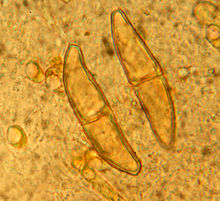Teleutospore

The teleutospores (also known as teliospores ) are a spore form of the rust and smut fungi that are used for wintering. Teleutospores develop towards autumn, mostly in the uredospore beds of the rust fungi or in the infected parts of the plants of the smut fungi. The fungal mycelium is equipped with two haploid nuclei (dikaryont) until the teleutospores form . Nuclear fusion ( karyogamy ) then occurs in the teleutospores . Teleutospores have a thick cell wall with germ pores, which protects against cold and dehydration in winter. In rust fungi, they usually consist of two cells (= probasidia ), such as B. the black rust of grain Puccinia graminis . However, they can also be single-celled (e.g. Uromyces spec.) Or multicellular (e.g. Phragmidium spec.). They also have a short stem that when fully developed they break off and then are spread by the wind.
In spring, each of the spore cells germinates under meiosis , and two haploid basidia are formed on each of which the basidiospores are then formed.